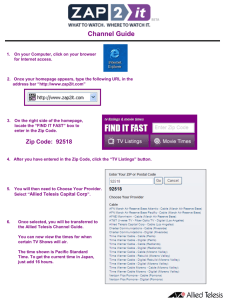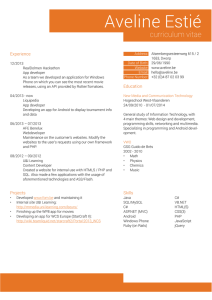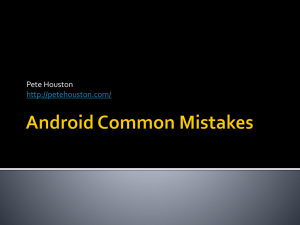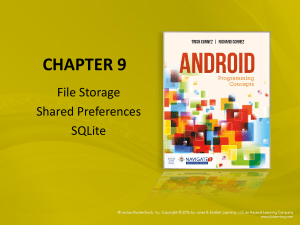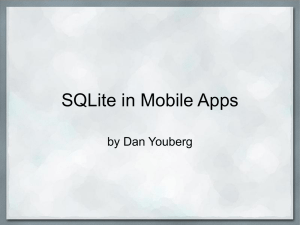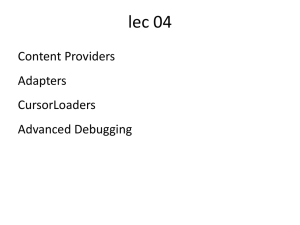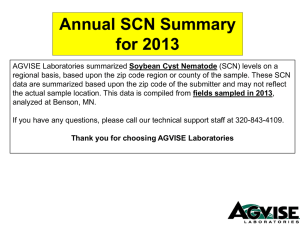Lecture 7 - Bhecker.com
advertisement
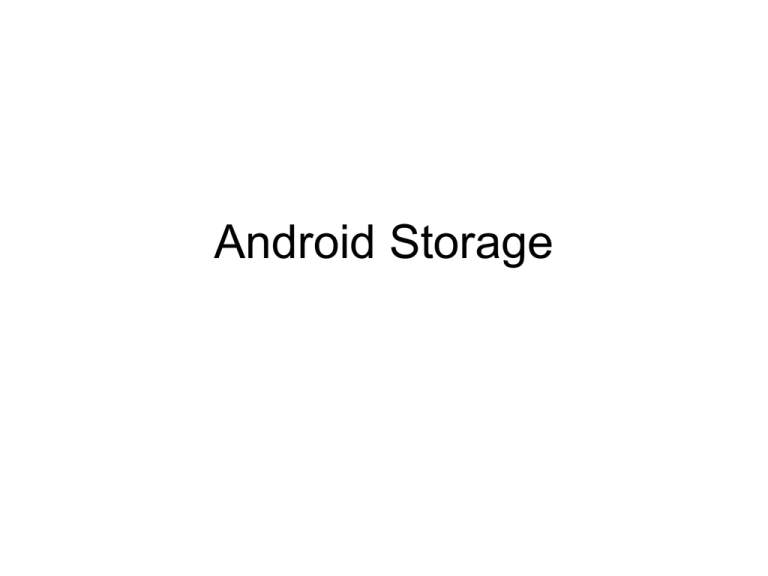
Android Storage
There are several options for
storage of data with Android
• We can put data into a preferences file.
• We can put data into a ‘normal’ file.
• We can send data across the network to a
service.
• We can use a database.
Preference files are a
light-weight option
• We can put data into a preferences file.
• Call Context.getSharedPreferences() to read
and write values as key-value pairs.
• Use Activity.getPreferences() with no name
to keep them private to the calling activity
• These are not sharable across applications,
unless you expose them as a ‘content
provider’.
We can write larger data to file
You can only access files available to the application
• You can either write to a new file, or to a preincluded file under res/raw/mydata
• To can read data from a file, call
Context.openFileInput() and pass it the local name
and path of the file. It returns a standard Java
FileInputStream object.
• To write to a file, call Context.openFileOutput() with
the name and path. It returns a FileOutputStream
object.
We can place data elsewhere on
the network
Use a web service to store data elsewhere.
Can make this automatic, or at user
discretion. (twitter apps, or photo capture)
We can also persist data to a db
• Android API uses the built-in SQLite db.
• Each db is private to the application. In
principle you could expose the data, if you
expose the application as a content
provider.
• All databases, SQLite and others, are
stored on the device in
/data/data/package_name/databases.
Android Notepad tutorial uses
database
Useful db helper class for access and crud details
Context Menu is special
• Acquire context menu by holding down
selection key, which then pops up context
menu
Unlocking Android db example
covers more complex example
Stores locations to database within application as
objects
Android app uses db helper
classes with sql
public static class Location {
Part of DBHelper class showing
Location object
public long id;
public long lastalert;
public int alertenabled;
public String zip;
// include city and region because geocode is expensive
public String city;
public String region;
public Location() {
}
Class also holds crud details to
map object to sql
public Location(final long id, final long lastalert, final int
alertenabled, final String zip,
final String city, final String region) {
this.id = id;
this.lastalert = lastalert;
this.alertenabled = alertenabled;
this.zip = zip;
this.city = city;
this.region = region;
Bruce Scharlau, University of Aberdeen, 2009
}
Android app maps objects to sql
for ease
public void insert(final Location location) {
ContentValues values = new ContentValues();
values.put("zip", location.zip);
values.put("city", location.city);
values.put("region", location.region);
values.put("lastalert", location.lastalert);
values.put("alertenabled", location.alertenabled);
this.db.insert(DBHelper.DB_TABLE, null, values);
}
Mapping makes
coding easier
public void update(final Location location) {
ContentValues values = new ContentValues();
values.put("zip", location.zip);
values.put("city", location.city);
values.put("region", location.region);
values.put("lastalert", location.lastalert);
values.put("alertenabled", location.alertenabled);
this.db.update(DBHelper.DB_TABLE, values, "_id=" + location.id, null);
Bruce Scharlau, University of Aberdeen, 2009
}
SQLite provides advanced db
features
• There is transaction support
• You can use prepared statements based
on java.sql and set items as have done
before – faster and more secure
• You have a cursor to keep track of location
within a resultset
Can map objects to db
• Can read items from network as xml and
convert to objects, which map to db
• Enables off network use and can sync
later when connected
• Might be pushing limits of device though
with extra classes and memory usage
Summary
• Can use preferences for each app
• Can write/read files as with Java
• Can persist/read items over network
(when available)
• Can use SQLite one db per app

